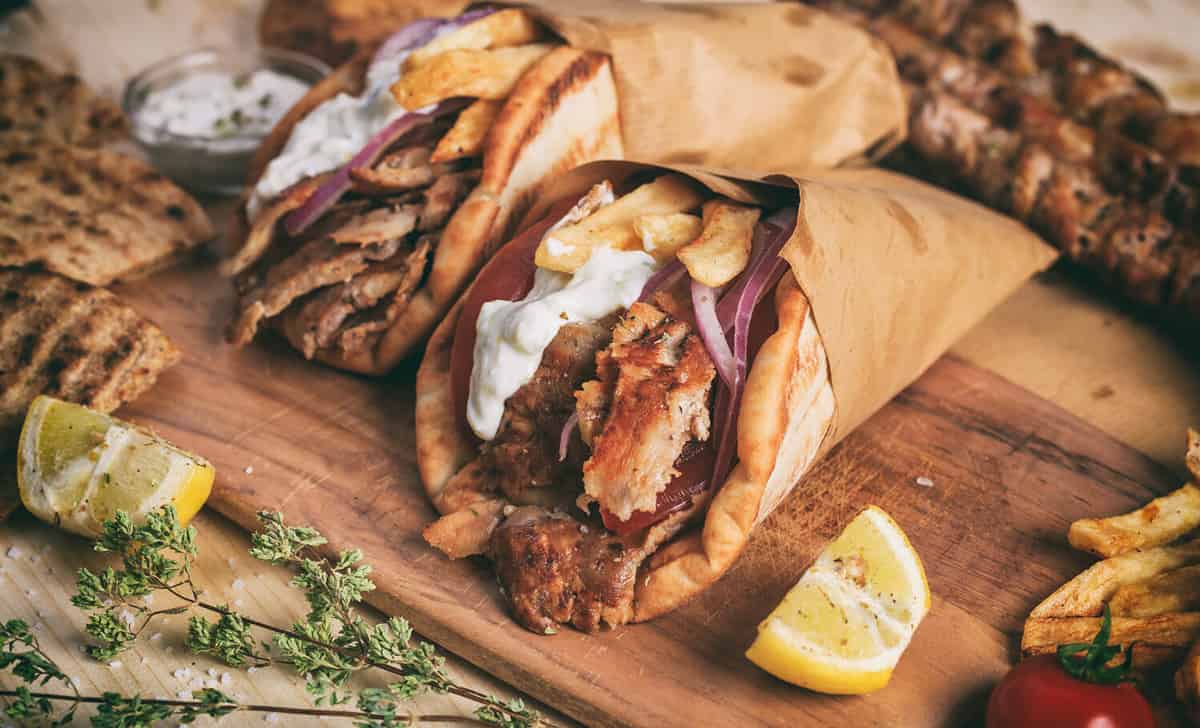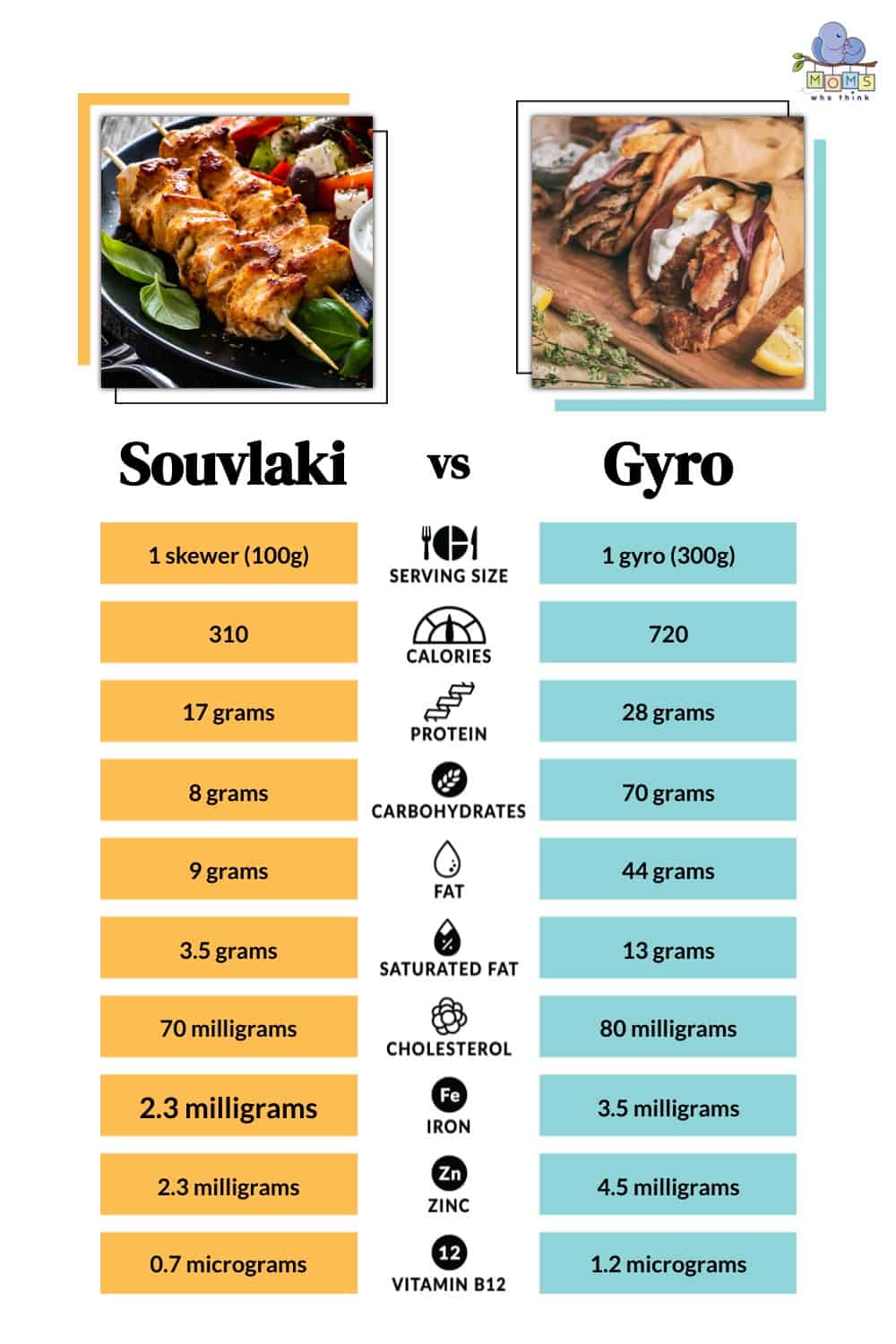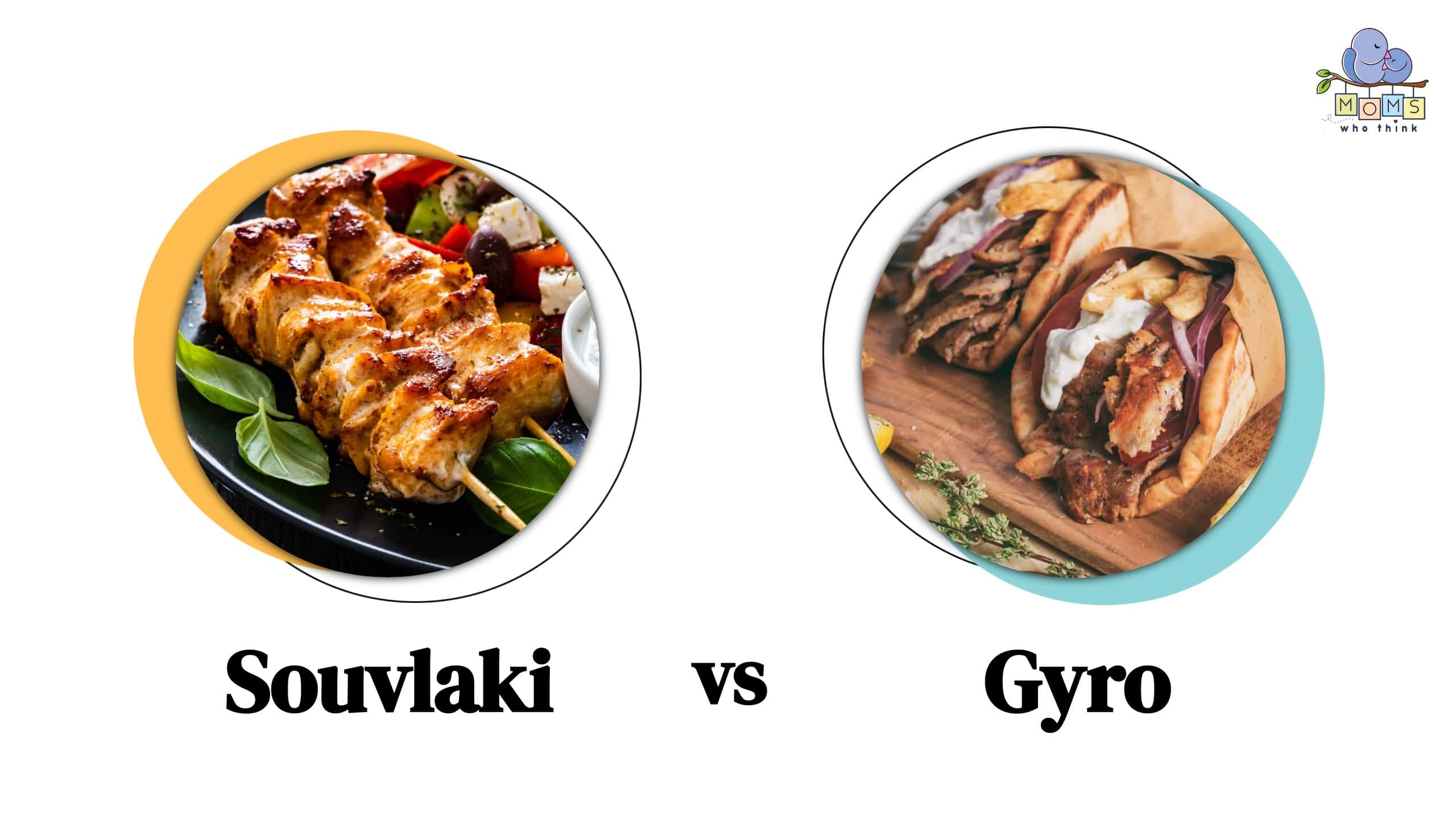Picture this: You’re standing in line at your favorite Greek restaurant, trying to decide what to order. You see souvlaki and gyro on the menu and wonder what the difference is. Even though these two meals do look similar, they have many distinctions as well.
The main difference between souvlaki and gyro is the way the meat is cooked. The meat from souvlaki is marinated and grilled while the meat from a gyro is cooked on a rotisserie. While souvlaki is typically served on a skewer and gyro is typically served in a pita, souvlaki can sometimes be served in a pita as well.
Souvlaki and gyros are two of the most popular meals in Greek restaurants. If you’re wondering about the difference between souvlaki and gyro, keep reading to find out more about how they differ.

©rawf8/Shutterstock.com
Souvlaki vs Gyro: What Is the Difference?
When you visit any Greek restaurant, you’ll likely find both souvlaki and gyro on the menu. Typically, you’ll see that souvlaki, such as chicken souvlaki, is meat served on a skewer with a side of rice, pita bread, or a side of Greek salad. On the other hand, a gyro is thin meat served in a pita with vegetables and tzatziki sauce.
In this case, it may seem easy to tell the difference between the two meals, but souvlaki isn’t always served on a skewer. Depending on where you order it from, the meat from souvlaki can sometimes be served on a pita as well. Even when they’re both served on a pita, there are still many differences between them.
The main difference between souvlaki and gyro is the meat. Whether chicken souvlaki or pork souvlaki, the meat is marinated and then grilled. Then, it’s served either on a skewer with a side of rice or in a warm pita.
Instead of having grilled meat, a gyro has meat that’s cooked on a vertical rotisserie. One of the most common types of meat for a gyro is a combination of beef and lamb, but you can also find gyros with pork, chicken, or different minced meats as well.
Both gyros and souvlaki are common dishes in Greek cuisine, and they’re both pretty tasty whether you serve them with rice, vegetables, or a Greek salad.
Main Differences Between Souvlaki and Gyro
While there are many differences between souvlaki and gyro, the main differences are:
- How they’re prepared
The main difference between souvlaki and gyro is the meat and how it’s prepared. While the meat in a souvlaki is marinated and then grilled, a gyro includes meat that was sliced off a vertical rotisserie. - How they’re served
While it isn’t always the case, souvlaki and gyro are typically served differently. While souvlaki is usually served on a skewer or on a plate, a gyro is always served in a pita. You may see souvlaki served in a pita as well, but this isn’t as common. - What fillings are included
Even if souvlaki is served in a pita, you’ll notice that a gyro generally has meat, tomatoes, onions, and tzatziki sauce.
Let’s take a closer look at what souvlaki is and how you can tell the difference between this dish and a gyro.
Nutritional Value of Souvlaki vs. Gyro

What Is Souvlaki?
Like many Greek dishes, souvlaki goes back all the way to ancient Greece. Based on recorded evidence, there may have been similar dishes in Greece thousands of years ago. We even see this dish mentioned in Homer’s The Iliad, where there’s talk of cooking pieces of meat on the fire.
The most popular way to serve souvlaki is on a skewer. The meat in souvlaki is meat that’s marinated and then grilled. However, it’s not always served on a skewer, and sometimes it’s served on a plate with a side of rice, or the meat is served inside a warm pita.
When served in a pita, this is when it resembles a gyro the most. Chicken souvlaki is common, but it can also be served with pork, lamb, or beef.
How to Make Souvlaki
Souvlaki is a bit more straightforward to make than a gyro, considering you need a rotisserie to make traditional gyro meat. If you have a place to grill, you can easily make your own version of souvlaki at home. The first step to making souvlaki is to marinate your meat.
The souvlaki marinade is made of a combination of olive oil, garlic, lemon juice, and other seasonings. You can marinate your meat of choice for a couple of hours or even overnight if you want to make it a day ahead of time.
Once the meat is done marinating, add it to skewers and place it on the grill until fully cooked. You can serve souvlaki on the skewers or remove them before serving. You can also choose to serve the meat in pita bread like a gyro.
Souvlaki meat is also great when served with:
- Vegetables
- Rice
- Greek salad
- Potato salad
No matter how you serve souvlaki, it can be a delicious and healthy meal that’s simple to make at home.
What Is a Gyro?
A gyro is another popular dish in Greek cuisine and is incredibly common, especially in Greek fast-food restaurants. While souvlaki-style meals go back to ancient Greece, the method of cooking gyro meat in a rotisserie didn’t start in Greece until the early 1900s.
If you order a gyro, you can expect warm pita bread filled with meat, vegetables, and other fillings. The name gyro actually doesn’t describe the type of meat. Instead, it’s a term to describe how the meat is cooked. Gyro meat is specifically meat that’s cooked on a vertical rotisserie. In fact, the name comes from a Greek word that means turn.
The meat in a gyro is cut into thin slices as it’s shaved off the rotisserie. This is one of the main ways you can distinguish the appearance of a gyro from souvlaki. Typically, souvlaki will have chunks or thick strips of meat, while the meat in a gyro will be thin. Traditionally, gyro meat is a combination of ground beef and ground lamb, but you can also make a gyro with chicken or pork.
Can You Make a Gyro at Home?
Traditionally, gyro meat is made on a vertical rotisserie, but it is possible to make a version of a gyro at home without the rotisserie.
At home, you can mix ground beef and ground lamb together in a food processor and then bake it like a meatloaf. After it’s fully cooked, sear it in a pan to mimic the type of meat used in a gyro. While it may not share the exact same flavor, it’s a simple way to enjoy this popular Greek meal at home.

©Jacek Chabraszewski/Shutterstock.com
Which Is Better: Souvlaki or Gyro?
If you’re wondering whether you should order a gyro or souvlaki next time you’re eating at a Greek restaurant, it depends on your preferences and dietary needs. While there are many differences between them, there are some similarities as well.
Both can be delicious meals, no matter how they’re served or what they’re served with. As far as their nutritional values, one skewer of souvlaki meat is going to have significantly fewer calories than a gyro, mainly due to the pita bread. If you're looking for a meal with fewer calories and fat, you're better off choosing the souvlaki.
Souvlaki vs. Gyro: Final Thoughts
There are many similarities and differences between souvlaki and gyros. Overall, it’s easier to tell the difference between them when souvlaki is served on a plate or a skewer. However, when it’s served in a pita, like a gyro, you might not notice the difference right away.
The main difference between them is the type of meat and how the meat is prepared. However, they’re often served differently and have different fillings as well. Overall, it’s up to you to decide which one is tastier.
Print
Healthy Gyro
Ingredients
For the Gyro Meat:
- 1 pound (450g) ground lamb or ground beef (or a mixture of both)
- 1 small onion, grated
- 2 cloves garlic, minced
- 1 teaspoon ground cumin
- 1 teaspoon ground coriander
- 1 teaspoon paprika
- 1/2 teaspoon ground cinnamon
- 1/2 teaspoon dried oregano
- Salt and black pepper, to taste
For the Tzatziki Sauce:
- 1 cup Greek yogurt
- 1/2 cucumber, grated and drained
- 2 cloves garlic, minced
- 1 tablespoon fresh lemon juice
- 1 tablespoon fresh dill, chopped (or 1 teaspoon dried dill)
- Salt and black pepper, to taste
For Assembling the Gyros:
- Pita bread or flatbread
- Sliced tomatoes
- Sliced cucumbers
- Sliced red onion
- Fresh lettuce or shredded lettuce
- Optional toppings: feta cheese, olives, and hot peppers
Instructions
1. Make the Gyro Meat:
- In a large mixing bowl, combine the ground lamb or beef, grated onion, minced garlic, ground cumin, ground coriander, paprika, ground cinnamon, dried oregano, salt, and black pepper. Mix well until all the ingredients are evenly incorporated.
- Cover the bowl and refrigerate the meat mixture for at least 1 hour to allow the flavors to meld.
2. Shape and Cook the Gyro Meat:
- Preheat your grill or a grill pan over medium-high heat.
- Take the seasoned meat mixture and shape it into a loaf or oval shape. If using a grill, you can shape it directly on skewers.
- Grill the meat for about 10-15 minutes, turning occasionally, until it's fully cooked and has a nice char on the outside. Alternatively, you can cook it in a pan if you don't have access to a grill.
3. Make the Tzatziki Sauce:
- While the meat is cooking, prepare the tzatziki sauce. In a bowl, combine the Greek yogurt, grated and drained cucumber, minced garlic, fresh lemon juice, chopped dill, salt, and black pepper. Mix well and refrigerate until serving.
4. Assemble the Gyros:
- Warm the pita bread or flatbread in the oven or on the grill for a minute or two.
- Slice the grilled gyro meat thinly.
- To assemble each gyro sandwich, place a warm pita or flatbread on a plate. Add slices of gyro meat, sliced tomatoes, sliced cucumbers, sliced red onion, and fresh or shredded lettuce.
- Drizzle a generous amount of tzatziki sauce over the top.
- If desired, add optional toppings like crumbled feta cheese, olives, and hot peppers.
5. Serve:
- Fold the pita or flatbread around the filling to create a gyro sandwich.
- Serve your homemade gyros immediately, while they are still warm and fresh.


